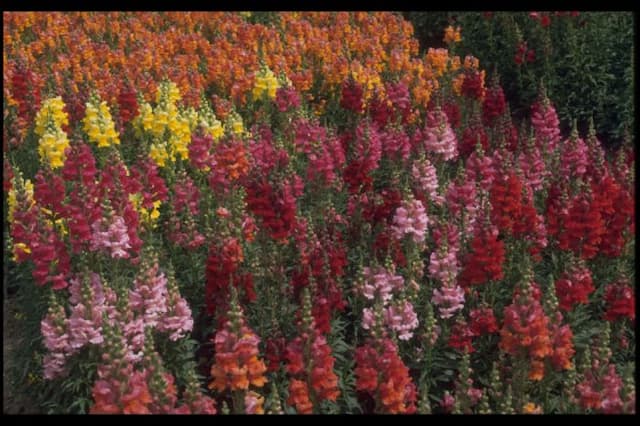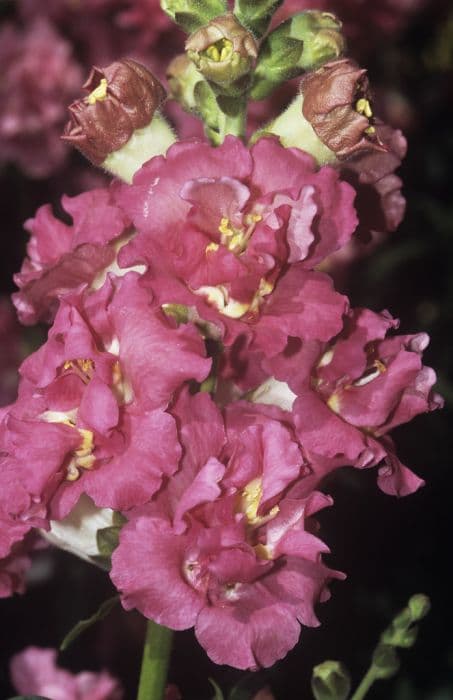Hebe Hebe 'Baby Marie'

ABOUT
Hebe 'Baby Marie' is an attractive, evergreen shrub known for its compact, rounded shape and dense foliage. The leaves are small, glossy, and oval-shaped with a dark green hue, providing a lush, year-round display of greenery. In late spring through summer, this plant blooms with an abundance of tiny, light purple to lilac flowers that form in small clusters at the tips of the branches. These delicate flowers add a splash of color against the dark green leaves, attracting bees and butterflies to the garden. The overall appearance of Hebe 'Baby Marie' is that of a neat and tidy plant with a bushy habit, making it a popular choice for garden borders, containers, or as a low hedge for a touch of elegance and structure.
About this plant
 Names
NamesFamily
Plantaginaceae.
Synonyms
Baby Marie Hebe, Veronica 'Baby Marie'.
Common names
Hebe 'Baby Marie'.
 Toxicity
ToxicityTo humans
Hebe 'Baby Marie', generally known as Hebe, is not known to be highly toxic to humans. However, it is always advisable to handle plants with care and avoid ingesting any part of plants not known to be edible. If ingested, it could potentially cause mild stomach upset or an allergic reaction in some individuals. Such allergic reactions could include symptoms like skin irritation or itchiness if there is physical contact with the sap. If any part of the plant is ingested and poisoning is suspected, medical attention should be sought.
To pets
Hebe 'Baby Marie' is not commonly known for being highly toxic to pets, such as dogs and cats. However, pets may have sensitivity to plants that humans do not, and ingestion can lead to gastrointestinal upset as a common symptom. If your pet exhibits signs of distress such as vomiting, diarrhea, drooling, or lethargy after consuming the plant, it is recommended to contact a veterinarian. It's always safest to prevent pets from ingesting ornamental plants as precautions.
 Characteristics
CharacteristicsLife cycle
Perennials
Foliage type
Evergreen
Color of leaves
Green
Flower color
Purple
Height
1.5 feet (45 cm)
Spread
1.5 feet (45 cm)
Plant type
Shrub
Hardiness zones
8
Native area
New Zealand
Benefits
 General Benefits
General Benefits- Low maintenance: Hebe 'Baby Marie' is known for being easy to care for, requiring minimal upkeep once established.
- Attractive foliage: The plant offers year-round interest with its glossy, evergreen leaves.
- Compact size: Its small size makes it ideal for container gardening, rockeries, and small garden spaces.
- Tolerant of coastal conditions: Hebe 'Baby Marie' is suitable for gardens near the sea as it can withstand salty winds.
- Attracts pollinators: The flowers of Hebe 'Baby Marie' can attract bees and butterflies, promoting biodiversity in the garden.
- Drought-resistant: Once established, it can tolerate periods of dry weather, making it suitable for drought-prone areas.
- Varied landscaping uses: It can be used for groundcover, as a border plant, or as part of a mixed shrubbery.
- Long blooming period: It produces flowers from summer to fall, providing a long season of visual interest.
 Medical Properties
Medical PropertiesThis plant is not used for medical purposes.
 Air-purifying Qualities
Air-purifying QualitiesThis plant is not specifically known for air purifying qualities.
 Other Uses
Other Uses- Living Sculptures: Hebe 'Baby Marie' can be shaped and maintained in miniature topiaries, providing a unique and artistic element to small garden spaces.
- Insectary Plant: This variety of hebe can be used to attract beneficial insects like bees and butterflies, facilitating pollination in the garden.
- Educational Projects: Due to its manageable size, Hebe 'Baby Marie' is ideal for teaching children about plant growth and horticulture.
- Photography Subjects: Enthusiasts can use the plant for macro photography, capturing the detail of its foliage and flowers.
- Themed Gardens: Hebe 'Baby Marie' can complement ocean-themed gardens with its blue and purple hues simulating sea colors.
- Craft Projects: The flowers and leaves can be used in dried floral arrangements or pressed flower art.
- Fairy Gardens: The compact growth habit of Hebe 'Baby Marie' is perfect for use in whimsical fairy gardens.
- Bonsai Practices: With proper care, this plant might be cultivated as a bonsai for those seeking to grow non-traditional bonsai specimens.
- Container Displays: Hebe 'Baby Marie' is well suited for container gardening, adding structure and color to balconies and patios.
- Culinary Garnish: Though not commonly known for culinary uses, the flowers are edible and can provide a decorative touch to salads or desserts.
Interesting Facts
 Feng Shui
Feng ShuiThe Hebe plant is not used in Feng Shui practice.
 Zodiac Sign Compitability
Zodiac Sign CompitabilityThe Hebe plant is not used in astrology practice.
 Plant Symbolism
Plant Symbolism- Youthfulness: The plant is associated with youth due to the name 'Hebe', which in Greek mythology is the goddess of youth.
- Rejuvenation: Hebe plants are known for their rejuvenating qualities, symbolizing new growth and vitality.
- Endurance: They are hardy plants that can withstand various conditions, representing perseverance and the ability to endure challenges.
- Protection: Some believe that Hebe plants can offer protection, representing safety and shelter in various cultures.
- Unity: The dense, compact growth habit of 'Baby Marie' may symbolize togetherness and the strength of unity.
 Water
WaterThe Veronica Baby Marie, also known as Hebe 'Baby Marie', should be watered regularly to keep the soil moist but not waterlogged. Generally, watering once a week with about 16 ounces of water is sufficient, but this may vary depending on climate conditions and the plant's environment. During hot, dry periods, the plant may need more frequent watering, while in cooler or rainy conditions, you should water less often. It's essential to ensure good drainage to prevent root rot, so make sure any excess water can escape and that the plant isn't left standing in water.
 Light
LightVeronica Baby Marie thrives best in full sun to partial shade conditions. Ideally, it should receive at least six hours of sunlight each day. A spot that offers morning sunlight and some protection from the intense afternoon sun could be optimal, especially in hotter climates. The plant's foliage and blooms will be most prolific when the light conditions are met adequately.
 Temperature
TemperatureVeronica Baby Marie prefers a moderate temperature range and can tolerate a certain degree of frost. It thrives in temperatures between 50 and 75 degrees Fahrenheit but can survive in temperatures as low as 20 degrees Fahrenheit and as high as 85 degrees Fahrenheit. Protect the plant from extreme cold by providing mulch or moving it to a sheltered location if it is in a container.
 Pruning
PruningPruning Veronica Baby Marie is important to maintain its shape and encourage bushier growth. Prune the plant in early spring before new growth begins, removing any dead or damaged stems. Additionally, after blooming, trim back the flower spikes by up to half to promote a second flush of flowers. Once a year pruning is usually sufficient unless the plant becomes too unruly or damaged by cold weather.
 Cleaning
CleaningNot needed
 Soil
SoilHebe 'Baby Marie', also known as Veronica, thrives in well-draining soil with a mixture of peat, perlite, and sand. The ideal soil pH for Veronica should be between 6.5 to 7.5, ensuring it's slightly acidic to neutral.
 Repotting
RepottingVeronica or Hebe 'Baby Marie' should be repotted every 2-3 years to refresh the soil and accommodate root growth. Frequency may vary based on the plant's growth rate and size of the pot.
 Humidity & Misting
Humidity & MistingVeronica, commonly referred to as Hebe 'Baby Marie', prefers moderate humidity levels ranging from 40-60% for optimal growth.
 Suitable locations
Suitable locationsIndoor
Ensure bright indirect light and consistent temperature for Hebe 'Baby Marie'.
Outdoor
Place Hebe 'Baby Marie' in partial shade with shelter from harsh wind.
Hardiness zone
8-11 USDA
 Life cycle
Life cycleHebe 'Baby Marie', commonly known as just Hebe, begins its life cycle when its seeds germinate in moist, well-drained soil, preferably in partial to full sunlight. The seedlings emerge and develop into juvenile plants with a dense, bushy growth habit featuring glossy green leaves. As the plant matures, it enters its flowering stage, typically in early summer, producing small, attractive flowers which can range in color from white to violet, depending on the variety. After pollination, which is often facilitated by bees and other insects, the flowers develop into small capsules containing seeds, completing the reproductive cycle. The Hebe plant can live for several years, during which it will bloom annually, given proper care including regular pruning to maintain shape and encourage new growth. In the final stage of its life, the plant's growth slows down, it may become more susceptible to diseases or environmental stress, and will eventually die after exhausting its lifespan.
 Propogation
PropogationPropogation time
Spring-Early Summer
The most popular method of propagating Hebe 'Baby Marie', a charming evergreen shrub known for its compact growth and attractive foliage, is by semi-ripe cuttings. The ideal time for this is in late summer to early fall. To propagate, select healthy, non-flowering shoots from the current year's growth and cut sections about 2-4 inches (5-10 cm) long. Strip the lower leaves and dip the cut end into a rooting hormone to encourage root growth. Then, insert the cuttings into a pot filled with a mix of peat and perlite or sand to provide aeration and drainage. The pot should be placed in a warm area with indirect light and kept moist but not waterlogged. Rooting typically takes place within 6-8 weeks, after which the new plants can be gradually acclimatized to outdoor conditions and eventually transplanted into the garden.





![Snapdragon [Pretty in Pink]](/_next/image?url=https%3A%2F%2Fplants-admin.emdemapps.com%2Fimages%2Fplants%2F%2Fimages%2F604b5cb3b5385.png&w=640&q=75)



